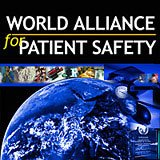The first challenge launched by the World Alliance for Patient Safety focusing on the prevention of healthcare-associated infection.
 The vision was simple: to initiate a commitment by all ( policymakers, frontline staff, patients, and managers) to make “Clean Care is Safer Care” an everyday reality in all countries and everywhere that health care is provided.
The vision was simple: to initiate a commitment by all ( policymakers, frontline staff, patients, and managers) to make “Clean Care is Safer Care” an everyday reality in all countries and everywhere that health care is provided.
The challenge promotes hand hygiene, blood safety, injection and immunization safety, safer clinical practices and safer water, and sanitation and waste management.
Objectives:
Aware - Commit - Implement
- Raise awareness of the impact of health care–associated infections on patient safety and promote preventive strategies within countries;
- Build commitment from countries to prioritize reducing health care–associated infections; and
- Test the implementation of the new WHO Guidelines on Hand Hygiene in Health Care (advanced draft) in specific districts worldwide as part of an integrated package of actions derived from existing WHO strategies in the areas of clean products (blood safety), clean practices (safe clinical procedures), clean equipment (injection and immunization safety), and clean environment (safe water and sanitation in health care).
Action Areas:
- Prevention of health care–associated infection.
- Patients for Patient Safety: Mobilizing patients and patient organizations to become involved in patient safety efforts worldwide
- Taxonomy for Patient Safety: Developing internationally acceptable data standards for collecting, coding, and classifying adverse events and near misses
- Research for Patient Safety: Improving tools and methods to measure patient harm in developing countries and defining a global patient safety research agenda
- Solutions for Patient Safety: Spreading proven patient safety interventions worldwide and coordinating international efforts on future solutions
- Reporting and Learning: Generating tools and guidance for developing patient safety reporting systems and improving existing systems within countries
Recommended Actions:

- Hand hygiene
- Strengthen high-level commitment within countries to implement national strategies to promote hand hygiene
- Test implementation of the WHO Guidelines on Hand Hygiene in Health Care (advanced draft) in several districts worldwide
- Blood safety
- Promotion of optimal hand hygiene associated with procedures for collection, processing, and use of blood products
- Promotion of donor skin antisepsis to prevent blood contamination
- In-service education and training on safe transfusion practices at the bedside
- Injection practices and immunization
- Promotion of optimal hand hygiene at time of intravenous injection and immunization
- Strengthen high-level commitment within countries to use auto-disable syringes for immunization services
- Actions around ensuring safe disposal of sharps as part of an integrated management of waste within healthcare facilities
- Water, basic sanitation, and waste management
- Actions to ensure access and quality of water to support hygiene and hand hygiene in particular, at a health care facility level
- Actions to ensure safe disposal of sharps
- Clinical procedures
- Specific education programs promoting safety in surgical procedures, tailored to the major needs of the countries
- Surgical hand preparation using either antimicrobial soap and water or alcohol-based handrub to reduce infections associated with surgical procedures
- Access to safe emergency surgical care: availability and actual usage of procedures and equipment for a specific set of clinical procedures
Source:
Clean Care is Safer Care: The First Global Challenge of the WHO World Alliance for Patient Safety,Vol. 26 No. 11


Dr. Khalid Abulmajd
Healthcare Quality Consultant